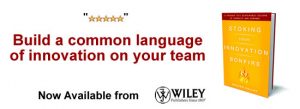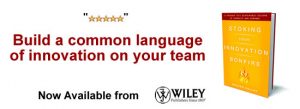Balancing Innovation Supply and Demand
 To build and sustain a robust innovation capability, your company needs to carefully manage both the supply side and the demand side of innovation. By “supply†I mean the sheer flow—and the quality—of new ideas entering your innovation pipeline and moving through its various stages. By “demand†I mean the natural, reflexive pull for those ideas within and across the businesses.
To build and sustain a robust innovation capability, your company needs to carefully manage both the supply side and the demand side of innovation. By “supply†I mean the sheer flow—and the quality—of new ideas entering your innovation pipeline and moving through its various stages. By “demand†I mean the natural, reflexive pull for those ideas within and across the businesses.
When supply is low, one tends to see a kind of idea inflation, meaning that opportunities are presented (often unintentionally) with an inflated sense of their value. This is simply because there are few other viable growth opportunities in the portfolio to pursue. The inherent risk here is that an organization invests substantially in what are actually quite mediocre ideas—ones that are unlikely to drive any significant revenue growth.
Conversely, when demand is low—when the organization is not naturally and reflexively able to respond to, nurture, and act on potential game-changing opportunities—then innovation withers. What invariably happens is that innovators become cynical and discouraged as they watch their projects go nowhere—which eventually dries up the flow of new ideas entering the pipeline.
Managing both the supply side and the demand side of innovation is a critical balancing act—one that must be mastered if you want to dramatically raise your company’s innovation outputs. Here are some specific principles and techniques that will help you manage this supply-demand equation.
First, how can you maximize the supply side of innovation—by making sure that a surfeit of new ideas and opportunities is being sourced within the organization as well as beyond its borders? In a previous post I outlined a whole set of specific actions your company can initiate to push up the quantity and quality of ideas entering the pipeline. In addition to these activities, there are four critical enablers:
1. Innovation training
What goes wrong with a lot of innovation programs is that ordinary employees are being asked to submit creative ideas, but they are not being trained to think like radical innovators. By contrast, the appliance giant Whirlpool has already trained tens of thousands of its people in the skills and the tools of innovation—employing not just a classroom setting but also broad-based e-learning.
2. Company’s IT infrastructure
Today, there is an abundance of technologies and tools that can help companies create a shared space for connection, conversation, and collaboration around innovation. Idea management systems are now becoming much more commonplace inside large companies, and they are doing a lot to distribute the responsibility for generating new ideas—and developing new business strategies—throughout the organization and beyond its walls. A recent addition to this field is a software tool called Discovery Suite—based on my systematic “Four Lenses of Innovation†methodology—which I have co-developed with Imaginatik as an extension of their popular Idea Central solution.
3. Rewards and Recognition
By this, I don’t necessarily mean financial incentives, although these may play a legitimate role. Because, for most people, the biggest reward from innovation has nothing to do with money. It has to do with the sheer joy of creating something new, of following an exciting idea that came out of their own head. So in addition to giving people an incentive to generate ideas, it’s also about giving them the chance to actually make their ideas happen, and about recognizing them for their contribution—perhaps at an annual innovation awards ceremony—even if their idea doesn’t finally pan out.
4. Coaching and Mentoring
Would-be innovators have to know where they can go to get coaching and advice from an impartial mentor—not their boss—who can help them build their idea, qualify it, and get it into a system where it can be formally considered for funding, nurturing and project development.
When these four enablers become an integrated part of a company’s organizational system for innovation, they go a long toward creating the cultural conditions out of which breakthrough ideas can continually emerge. But what about the other side—the demand side—of innovation? Is your company putting as much effort into driving innovation demand as it is into driving innovation supply?
The fundamental challenge here is a leadership challenge.
If you want to drive up innovation demand inside your own organization, start by making your senior leaders responsible and accountable for innovation. Create incentives for them to mentor and nurture the prospective innovators within their ranks. Jeff Immelt, chairman and CEO of GE, has made it very clear that he expects his divisional presidents to own the innovation agenda in their area of responsibility, and he takes them to task on this when they meet with him every quarter. He has even changed their compensation packages, tying remuneration to their ability to spur innovation inside their businesses.
One of the dilemmas today is that, in most companies, the pressure to innovate is not very real and tangible to managers. What is real and tangible— and in many cases enormous—is the pressure to meet the numbers. However, in most cases, there is no similar pressure on senior executives that holds them directly accountable for the company’s innovation processes. To this end, here are three very important pressure points your company can use for driving innovation demand, all of which concern leadership actions and behaviors:
1. Budgeting Process
Try telling your operating units they have to set aside a certain percentage of their capital or operating budget for projects that are radically innovative, but without relaxing their normal performance objectives. Tell them they need to develop a “dual focusâ€â€”both on short-term performance and long-term growth. While this is admittedly difficult inside any organization, it is key to making managers accountable for innovation.
2. Management Compensation.
Look at the typical compensation package of a divisional executive. To what extent is the remuneration and reward system tied to innovation performance? Often, it’s not linked at all. Therefore, how could we seriously expect business unit leaders to make innovation a priority? By changing performance metrics and management compensation packages to make them pro-innovation, your company can measurably improve its capacity to create new business opportunities.
3. Bold Growth Targets
Companies don’t usually outperform their aspirations. The beliefs of your employees set the upper limit on what’s possible. If your expectation for top-line growth is pinned to the industry average, all you will get from your organization is average performance—people will continue to do things the same way, perhaps tweaking a bit here and trimming a bit there. If, on the other hand, you give your divisional executives unreasonable growth targets—irrespective of the intrinsic growth rates of the markets they are in—the chances are much higher that they will find innovative ways to dramatically outperform the average. They will be forced to think differently and do things differently.
Conclusion
Finally, of course, driving innovation demand is not purely about the numbers. It is also about creating well articulated and meaningful challenges that speak to employees’ hearts as well as their heads. For example, a challenge like “How can we increase our earnings per share by 20 percent?†is certainly not going to inspire as much innovation as the kind of challenge you regularly hear in Apple’s Cupertino headquarters: “How can we change the world?â€
Once employees get the feeling that they are part of a vibrant, innovative company that is out to make history, and not just profits; once they get hooked on the excitement and energy of innovation, they automatically begin to demand more innovation from themselves and their peers. Thus, the demand for innovation ceases to be the sole province of the CEO or other top level executives. All levels of the organization begin to drive innovation, because they believe that their company can truly “make a dent in the universe.â€
Don’t miss an article (3,000+) – Subscribe to our RSS feed and join our Innovation Excellence group!
 Rowan Gibson is widely recognized as one of the world’s leading experts on enterprise innovation. He is co-author of the bestseller “Innovation to the Core” and a much in-demand public speaker around the globe. On Twitter he is @RowanGibson.
Rowan Gibson is widely recognized as one of the world’s leading experts on enterprise innovation. He is co-author of the bestseller “Innovation to the Core” and a much in-demand public speaker around the globe. On Twitter he is @RowanGibson.
NEVER MISS ANOTHER NEWSLETTER!
LATEST BLOGS
The Second Coming of the Retail Health Clinic
There used to be a day when you could go to your local barber and get all sorts of wonderful…
Read MoreCan Microsoft out-innovate Google?
Microsoft announced today a round of updates to its Live Search offering. Searchengineland had a good story on the developments.…
Read More




It’s interesting that the rewards and recognition for innovators don’t necessarily involve financial incentives, but the rewards and recognition recommended for executives are almost entirely so. The carrot (compensation) and stick (budget allocation) that are recommended to help balance the attention and behavior of executives and managers between near term performance and long term opportunity/potential don’t seem to recognize other factors that motivate people in these roles.
Does this imply that the only thing they respond to is money? I hope not. Perhaps the CEO and other leaders need to establish other kinds of incentives for managers, too. These roles are a key part of the innovation pipeline, too. So perhaps they should be recognized for the other things they do to create and enable innovation. Then those who aspire to becoming executives will begin to see the kind of thinking, behaviors, and perspectives that are valued by the organization – and that they don’t just involve the balance sheet.
Great insight into how organizations can motivate and improve innovation. Like the idea that all employees within a company can can contribute to some form of creativity and improvement. When recognized helps morale and stability of any organization.